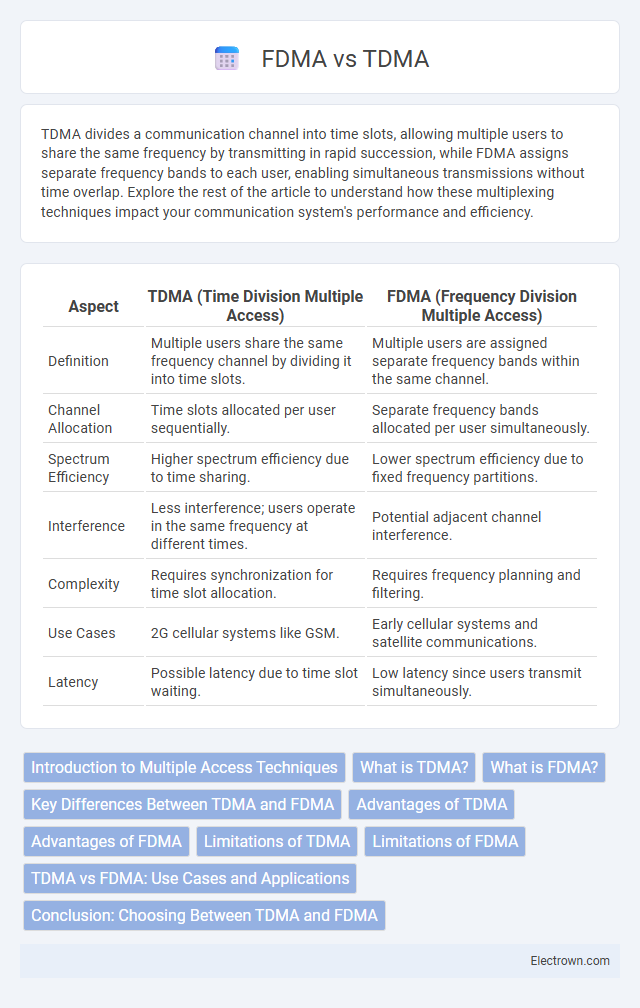TDMA divides a communication channel into time slots, allowing multiple users to share the same frequency by transmitting in rapid succession, while FDMA assigns separate frequency bands to each user, enabling simultaneous transmissions without time overlap. Explore the rest of the article to understand how these multiplexing techniques impact your communication system's performance and efficiency.
Table of Comparison
| Aspect | TDMA (Time Division Multiple Access) | FDMA (Frequency Division Multiple Access) |
|---|---|---|
| Definition | Multiple users share the same frequency channel by dividing it into time slots. | Multiple users are assigned separate frequency bands within the same channel. |
| Channel Allocation | Time slots allocated per user sequentially. | Separate frequency bands allocated per user simultaneously. |
| Spectrum Efficiency | Higher spectrum efficiency due to time sharing. | Lower spectrum efficiency due to fixed frequency partitions. |
| Interference | Less interference; users operate in the same frequency at different times. | Potential adjacent channel interference. |
| Complexity | Requires synchronization for time slot allocation. | Requires frequency planning and filtering. |
| Use Cases | 2G cellular systems like GSM. | Early cellular systems and satellite communications. |
| Latency | Possible latency due to time slot waiting. | Low latency since users transmit simultaneously. |
Introduction to Multiple Access Techniques
Multiple access techniques such as Time Division Multiple Access (TDMA) and Frequency Division Multiple Access (FDMA) enable multiple users to share the same communication medium without interference. TDMA allocates distinct time slots to each user within the same frequency band, maximizing spectral efficiency and reducing latency. FDMA assigns separate frequency channels to users, ensuring continuous data transmission while simplifying hardware implementation for your communication system.
What is TDMA?
TDMA (Time Division Multiple Access) is a channel access method that divides each frequency channel into multiple time slots, allowing several users to share the same frequency without interference by transmitting in rapid sequence. It efficiently allocates bandwidth by assigning unique time intervals to different users, maximizing channel utilization in digital communication systems. TDMA is widely used in 2G cellular networks and other wireless protocols where time-based multiplexing improves spectrum efficiency.
What is FDMA?
FDMA (Frequency Division Multiple Access) allocates distinct frequency bands to each user for simultaneous communication within the same channel, optimizing spectral efficiency in wireless networks. This technology reduces interference by separating users in the frequency domain, making it ideal for continuous data transmission in systems like traditional cellular and satellite communications. Understanding FDMA helps you evaluate multiple access techniques used in mobile network design and deployment.
Key Differences Between TDMA and FDMA
TDMA (Time Division Multiple Access) divides the channel into time slots, allowing multiple users to share the same frequency by transmitting in rapid succession, while FDMA (Frequency Division Multiple Access) separates users by allocating distinct frequency bands for each user. TDMA provides improved spectral efficiency and reduces interference through time-based sharing, whereas FDMA offers simplicity in implementation but with more rigid frequency allocation and potential bandwidth wastage. Your choice between TDMA and FDMA depends on the specific requirements for capacity, latency, and hardware complexity in the communication system.
Advantages of TDMA
TDMA offers efficient bandwidth utilization by dividing channels into time slots, enabling multiple users to share a single frequency channel without interference. It reduces signal collision and improves capacity and system throughput compared to FDMA. The time-slot-based structure also enhances power efficiency and allows dynamic allocation of resources based on user demand.
Advantages of FDMA
FDMA (Frequency Division Multiple Access) offers clear advantages such as simpler implementation and continuous transmission for each user, enabling stable and predictable bandwidth allocation. It reduces the complexity of synchronization compared to TDMA, making it suitable for analog and low-data-rate communication systems. FDMA's resistance to timing errors enhances signal integrity and facilitates smoother operation in environments with variable user activity.
Limitations of TDMA
TDMA faces limitations such as reduced efficiency in handling variable traffic loads due to fixed time slot allocations, leading to potential idle periods and wasted bandwidth. Synchronization requirements are stringent, increasing system complexity and susceptibility to timing errors. Your communication quality may degrade in high-mobility environments where rapid time slot handoff is challenging.
Limitations of FDMA
FDMA faces limitations such as inefficient bandwidth utilization due to fixed frequency allocation, which restricts the number of simultaneous users in a given spectrum. It suffers from inter-channel interference and requires guard bands to prevent signal overlap, further reducing spectral efficiency. FDMA's rigidity makes it less adaptable to dynamic traffic demands compared to TDMA, which divides channels by time slots for better flexibility and capacity.
TDMA vs FDMA: Use Cases and Applications
TDMA (Time Division Multiple Access) is commonly used in cellular networks like GSM, where multiple users share the same frequency channel by dividing it into time slots, making it ideal for voice communication with efficient bandwidth utilization. FDMA (Frequency Division Multiple Access) assigns individual frequency bands to each user, making it suitable for traditional radio and satellite communication systems where continuous, dedicated frequency allocation is needed. TDMA excels in environments requiring synchronized time-slot management and dynamic channel access, whereas FDMA is preferred in systems demanding constant frequency separation and minimal inter-user interference.
Conclusion: Choosing Between TDMA and FDMA
Choosing between TDMA and FDMA depends on specific network requirements such as bandwidth efficiency, interference management, and synchronization complexity. TDMA offers higher spectral efficiency by allocating time slots dynamically, making it suitable for systems with fluctuating traffic. FDMA provides simpler implementation and continuous transmission, ideal for environments requiring steady and separate frequency channels.
TDMA vs FDMA Infographic

 electrown.com
electrown.com